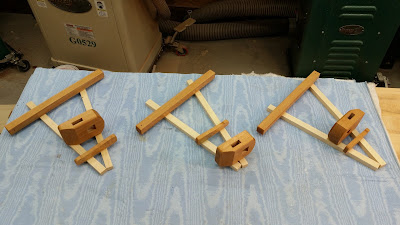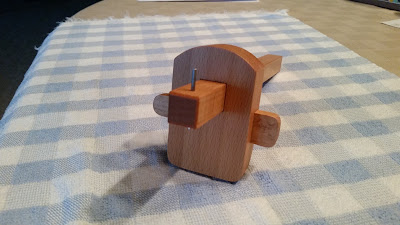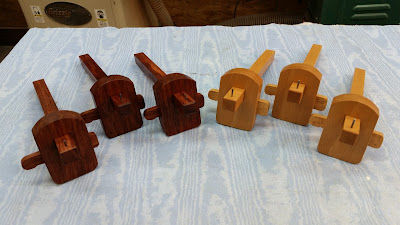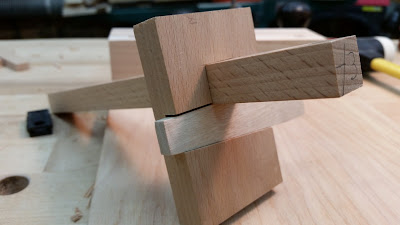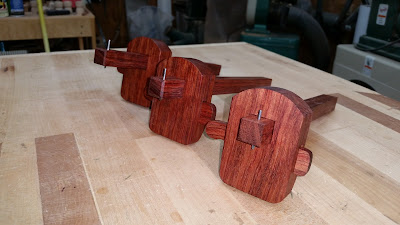After final sanding with 220 grit, I was ready for finish. I used Chris Schwarz workbench finish. Equal parts oil based varnish (I use satin) boiled linseed oil, and odorless mineral spirits. I wiped on two coats with a piece of old tee-shirt. I let the first coat dry overnight and the second coat dry for two days.
The beech takes on a nice color with the first coat of finish. The original color was almost as white as the pine sticks I have the parts sitting on.
The final step of the finish was to clean up the parts with 0000 steel wool and apply a coat of paste wax.
The last part I needed was the steel marking pin. I made these from music wire that measured .078 inch diameter. I cut them 1-1/8 inches long. I filed the flat and used a bench grinder with an 80 grit wheel to round the back side. It ends up being kind of a football shaped.
I heated these to bright red and quenched in water then tempered them to straw color. OK, some of them may have been more blue than straw. You have to be very careful when heating something this small. Either way, then are harder than when I started.
I refined them on my sharpening stones until I had a nice sharp edge.
I laid out the hole location 3/8 inch from the end of the beam. Then used my drill press with a #48 drill bit which measures .076 inch diameter. This proved to be a little too tight so I ran the same drill through again using a cordless drill and it took out just enough to make the pin fit. It's still pretty tight, I tapped them in with a small hammer. I think that's the kind of fit you want so it won't slip.
This was a fun project and I'm very pleased with the way these turned out.
You may be wondering why I need six marking gauges. I plan to keep three and give the rest to friends who also enjoy woodworking.
Friday, May 20, 2016
Thursday, May 19, 2016
Marking Gauges Part 2
I made a layout wedge out of scrap to help mark the mortise for the locking wedge. I can't swear to it but I think I used 10 degrees.
I knifed in the first line about 1/32 inch above the bottom of the beam mortise using a square. I deepened the line slightly with a chisel then chiseled out a little wedge of material. I deepened the knife line again and removed more material until I could set my layout wedge against the knife line. This way I could use the wedge as a guide to knife the second line.
I used a carcase saw to cut down both sides of the mortise then removed the bulk of the waste with a chisel followed up by a router plane.
The front piece has the knife lines and chiseling to guide the saw.
In the back, you can see the beam extends slightly into the wedge mortise.
Here are both parts of the head before glue up. The front piece is a little more than 5/16 inch thick.
By leaving both parts a little bit thick, I could come back and plane off the layout lines later.
I resawed and numbered the parts so I could match up the grain when I glued them back together. This makes it look more like a single piece of wood when it's finished.
I used numerous spring clamps to hold it in place while the glue dried. I also used an F-clamp to keep the edges aligned.
I used a plane to clean up the long sides, making sure to keep them square to the top and the faces. Then I used a square, marking knife, and marking gauge to transfer the mortise location to the opposite side. I tightened my layout wedge into the wedge mortise to keep from blowing out the fibers inside the part when I chiseled through. I had some tear out but it was minor and won't be seen when the gauge is assembled.
I used the lid from a can of spray paint to mark the radius on top the head. I cut these on the bandsaw then cleaned them up at the disc sander.
I failed to get photos while making the wedges. On the first batch, I fitted the wedges before gluing the head halves back together. I think this made it a little easier to see just how well the wedge fits. I forgot this lesson on the second batch so it took a little longer but everything still worked out fine.
The back of the head gets a 30 degree bevel and the back edges were rounded over at the router table. I think I used a 3/16 radius, could be wrong, the bit was already in the router and it looked good on a test part. :)
Unlike the first batch, I made sure that I situated the parts so the thickest part of the head stock (the part with the wedge mortise) was at the back. This way, when I cut the 30 degree bevel, it doesn't expose the glue line. As you can see here, the glue line is practically invisible and the grain matches very well.
I broke the corners along the length of the beams with a block plane and chamfered both ends with a chisel.
Stay tuned for the conclusion.
Wednesday, May 18, 2016
Marking Gauges Part 1
I had seen this article and this tutorial on making traditional marking gauges which inspired me to make some of my own. I took some liberties with the process and the wedge orientation to come up with a method that is easy and fun using 'mostly' hand tools.
This article documents the construction of my second batch of gauges. The first batch came out fine but I didn't get many pics and I learned some things in the process that made the second batch a little bit nicer.
This is my first batch made with bubinga that was left over from another project.
I placed my wedges under the beam rather than on top as in the original.
I had seen one online with the wedge oriented this way. I think this makes it more comfortable to hold and use.
I decided to make the second batch of three from beech, since I had some quartersawn that I had bought a few years ago. I had 2x2 inch stock and was able to resaw it on the bandsaw to get the beams and stocks from one 9-1/2 inch length. I had to saw another 3-1/4 inch length to make the wedges. That left me with plenty of extra wedge material if I decide to make more gauges.
This is my beech stock roughed into beams, stocks, and wedges. The stocks or heads are resawn into two different thicknesses which will be glued back together during the build.
After planing away the bandsaw marks and squaring the stock, I marked out the mortise on both sides of the thicker piece of the head. These are 2 x 3 inches and a bit more than 5/8 thick.
I used a 9/16 Forstner bit to remove most of the waste. I roughly squared up the corners with a 1/4 inch chisel, then finished up with a 1/2 inch working from both sides. The finished mortise is approximately 5/8 inch square.
I was aiming for a close, slightly snug fit. It took some minor paring inside the mortise then planing the beam to fit.
I mortised all three before moving to the next step.
Stay tuned for part 2.
This article documents the construction of my second batch of gauges. The first batch came out fine but I didn't get many pics and I learned some things in the process that made the second batch a little bit nicer.
This is my first batch made with bubinga that was left over from another project.
I placed my wedges under the beam rather than on top as in the original.
I had seen one online with the wedge oriented this way. I think this makes it more comfortable to hold and use.
I decided to make the second batch of three from beech, since I had some quartersawn that I had bought a few years ago. I had 2x2 inch stock and was able to resaw it on the bandsaw to get the beams and stocks from one 9-1/2 inch length. I had to saw another 3-1/4 inch length to make the wedges. That left me with plenty of extra wedge material if I decide to make more gauges.
This is my beech stock roughed into beams, stocks, and wedges. The stocks or heads are resawn into two different thicknesses which will be glued back together during the build.
After planing away the bandsaw marks and squaring the stock, I marked out the mortise on both sides of the thicker piece of the head. These are 2 x 3 inches and a bit more than 5/8 thick.
I used a 9/16 Forstner bit to remove most of the waste. I roughly squared up the corners with a 1/4 inch chisel, then finished up with a 1/2 inch working from both sides. The finished mortise is approximately 5/8 inch square.
I was aiming for a close, slightly snug fit. It took some minor paring inside the mortise then planing the beam to fit.
I mortised all three before moving to the next step.
Stay tuned for part 2.
Subscribe to:
Posts (Atom)
